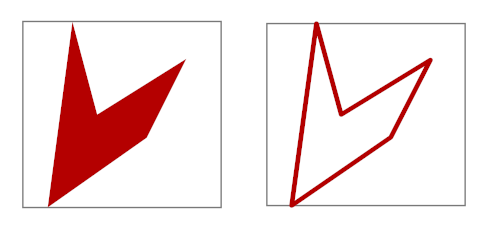Vertex Source Transforms¶
In the previous chapter we have seen how we can use some vertex source objects like path_storage to define any kind of geometric shapes. In this chapter we will discuss some very useful AGG classes that transforms a given vertex source object to a different one based on some specific rules. These kind of transformations can be ‘pipelined’ or chained together to easily define very complex object.
So a vertex source transform can be defined as a class that take one or more vertex source object references and returns an instance that is itself a vertex source object. This property of taking a vertex source in the input and giving a vertex source in output allows the combination on any number of transforms in a graphical pipeline.
Let us now illustrate some of the more important transforms to better illustrate the idea.
Stroking¶
The ‘stroke’ transform act on a given path, either a open or a closed one, and transform it to its outline. In term of mathematical topology we can say that it transform a set into its frontier. In very simple term we can express the idea by saying that it gives a lines that follow the boundary of the polygon. The object that you will obtain will be also a closed polygone with a non-zero width that outline the contour of the object.
To better illustrate the idea it let us shown un example. In the previois chapter we have seen how to create an irregular polygon using a path_storage object. Let us see now how we can apply to it a ‘stroke’ transform and how the results looks like. Here the code with the definitions:
// we define the polygon as before
agg::path_storage p;
p.move_to(0.0, 0.0);
p.line_to(20.0, 15.0);
p.line_to(28.0, 32.0);
p.line_to(10.0, 20.0);
p.line_to(5.0, 40.0);
p.close_polygon();
// we create a stroke object that takes the polygon as argument
agg::conv_stroke<agg::path_storage> line(p);
// we set the width of the stroke transform
line.width(1.0);
You can see that to define the ‘stroke’ transform we have used the class agg::conv_stroke. This class takes a template argument which is the type of the base object, in this case a agg::path_storage. The constructor of the stroke transform is trivial and it just takes a reference to the input object.
We show in the image below the results of the path p without transforms, on the left, and with a stroke transform, on the right.

An simple closed polygon and the result of a stroke transform